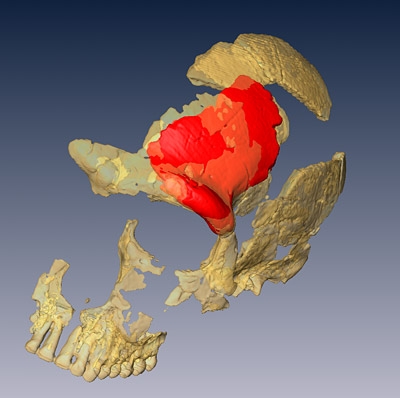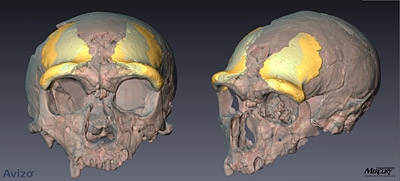A Neandertal fossil from the north sea
A fragment of a human skull discovered in sediments extracted from the bottom of the North Sea, 15 km off the coast off the Netherlands, has been identified as belonging to the extinct Neandertal group.
The extraction zone is located in the so-called Zeeland Ridges area. The specimen was dredged up from sediments containing Late Pleistocene faunal remains and Middle Paleolithic artifacts, including well-finished small handaxes and Levallois flakes.

The fragment was studied by an international group of scientists, headed by Prof. Jean-Jacques Hublin (Max Planck Institute for Evolutionary Anthropology) at Leipzig, Germany. Detailed studies of the morphology of the fragment unambiguously assign the Zeeland Ridges frontal bone to Homo neanderthalensis, and more specifically to a young adult male. The fragment’s best match is with skulls of Late Pleistocene Neandertals, notably those of La Chapelle-aux-Saints and La Ferrassie 1 (both in France), roughly 60-70,000 years old. The fragment is the first find of an extinct hominin retrieved from below the sea, and a dramatic illustration of the information potential of the shallow parts of the North Sea, and of continental shelves in general.
For most of the last two million years, sea levels were significantly lower than today, and substantial areas of the current North Sea were dry land, characterized by extensive river systems with wide river valleys and floodplains. These areas constituted rich habitats for large herds of herbivores and the animals that preyed upon them. The relatively shallow (<50m deep) southern bight of the North Sea is one of the richest fossil-bearing localities worldwide, with tons of Pleistocene mammal fossils brought ashore every year, including remains of woolly mammoth, woolly rhinoceros, horse, reindeer and bovids. These faunal remains are being retrieved by the fishing industry, by aggregates companies and during dredging operations related to the maintenance of navigation routes. The skull fragment is the first representative of a Pleistocene hominin from the North Sea.

The study will be published in the Journal of Human Evolution. From June 16th 2009 onward, the Museum of Antiquities at Leiden (The Netherlands) (www.rmo.nl) will host a small exhibition around the skull fragment.
Publication details
Title: Out of the North Sea: the Zeeland Ridges Neandertal
Authors: Jean-Jacques Hublin, Darlene Weston, Philipp Gunz, Mike Richards, Wil Roebroeks, Jan Glimmerveen, Luc Anthonis
Journal of Human Evolution: Journal homepage: www.elsevier.com/locate/jhevol
Corresponding author:
Prof. Dr. Jean-Jacques Hublin Director, Department of Human Evolution, Max Planck Institute for Evolutionary Anthropology, Deutscher Platz 6 D-04103 Leipzig Germany hublin@eva.mpg Tel: +49 (0)341 3550 351 Secr: +49 (0)341 3550 380 Fax: +49 (0)341 3550 399
